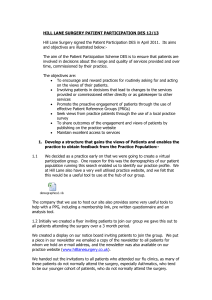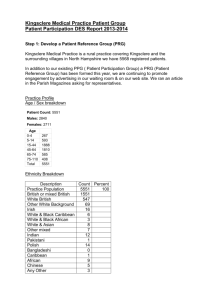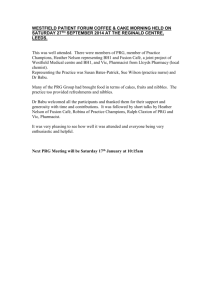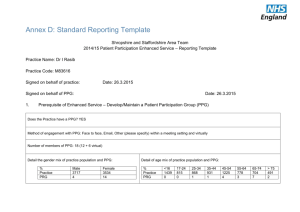Patient Participation Report 2015
advertisement
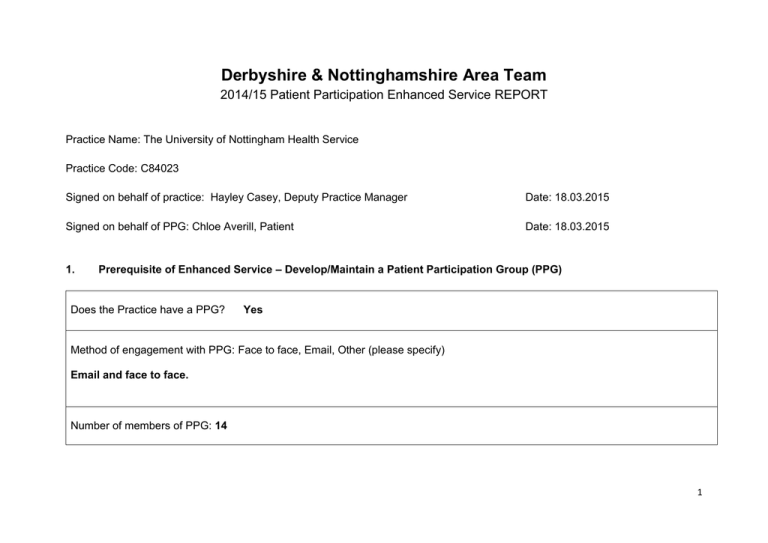
Derbyshire & Nottinghamshire Area Team 2014/15 Patient Participation Enhanced Service REPORT Practice Name: The University of Nottingham Health Service Practice Code: C84023 Signed on behalf of practice: Hayley Casey, Deputy Practice Manager Date: 18.03.2015 Signed on behalf of PPG: Chloe Averill, Patient Date: 18.03.2015 1. Prerequisite of Enhanced Service – Develop/Maintain a Patient Participation Group (PPG) Does the Practice have a PPG? Yes Method of engagement with PPG: Face to face, Email, Other (please specify) Email and face to face. Number of members of PPG: 14 1 Detail the gender mix of practice population and PPG: % Practice PPG Male 60% 35% Detail of age mix of practice population and PPG: Female 40% 64% % Practice PPG <16 2% 0 17-24 65% 50% 25-34 25% 15% 35-44 6% 7% Mixed/ multiple ethnic groups White &black White African &Asian 0.03% 0.02% 0 0 Other mixed 0 0 45-54 0.8% 0 55-64 0.7% 14% 65-74 0.4% 7% > 75 0.1% 7% Detail the ethnic background of your practice population and PRG: % Practice PPG British Irish 51% 93% 0.4% 0 White Gypsy or Irish traveller 0 0 % Practice PPG Indian Pakistani 7% 0 0.9% 0 Other white 13% 0 Asian/Asian British Bangladeshi 0.3% 0 White &black Caribbean 0 0 Chinese 16% 0 Other Asian 8% 7% Black/African/Caribbean/Black British African Caribbean Other Black 3% 0 0.05% 0 0 0 Other Any other 0.3% 0 0 0 Arab Describe steps taken to ensure that the PPG is representative of the practice population in terms of gender, age and ethnic background and other members of the practice population: The practice has a highly unusual demographic in terms of age and turnover of patients. Due to the somewhat short term nature of the student’s time spent at the University we naturally expect a high turnover of representatives, this reflects the practice’s overall annual patient turnover of 21.24% compared to a national average of 8%. Therefore, the practice continues to recruit on an ongoing basis. The practice has grown considerably in recent years due primarily to the number of postgraduate students attending the University of Nottingham and relocating with their families, often from abroad. The number of students remaining in Nottingham 2 following graduation and wishing to remain registered with the practice has also increased as has the number of students and staff members who choose to register with the practice rather than other local surgeries. For this reason, a number of patients who were members of the PRG last year have remained into this year and we would hope, will continue to be part of the group for a number of years to come. Recruitment has been ongoing, and as last year, we have used a variety of methods to recruit and advertise the group. This has included displaying advertisements within the practice, which highlights the group’s activities and invites patients to join. As mentioned in last years’ report, through strong links the practice has with the University of Nottingham Student’s Union, we invite representatives of the Student’s Union to join the group. In addition, information about how to join the PRG is advertised on our website and within the practice leaflet. This year, in an attempt to reach out to even more patients, we have displayed information on our electronic screens in all 3 waiting areas of the practice. The PRG has also decided to advertise the group through our new patient newsletter, which the group aim to distribute each term. Are there any specific characteristics of your practice population which means that other groups should be included in the PPG? e.g. a large student population, significant number of jobseekers, large numbers of nursing homes, or a LGBT community? Yes If you have answered yes, please outline measures taken to include those specific groups and whether those measures were successful: As a result of the above mentioned links with the Student’s Union, we have had representation from a range of SU officers such as the welfare and equal opportunities, mature students, postgraduates, LGBT and the women’s officer. The invitation to become a member of the group is made to all areas of the Student’s Union and this also includes the international societies, and those representing minority groups. Due to this ongoing and valued support of the Student’s Union and their representatives, the PRG has 3 been successful in being representative of all groups however; we will continue to work with the Student’s Union and the University’s International Office to encourage membership from International students in addition to promoting the PRG at the International Welcome Week across the campus. Because of the Practice’s highly unusual demographic with the majority of patients being either a student or in work, every attempt is made to work around the working/teaching patterns or our predominantly student-based group. In order to do this, some of our PRG contact is done electronically via email. This has particularly helped when the practice has needed to gain feedback from the group regarding the patient survey and Family and Friends Test results. The feedback is gained quickly via email. However, we believe it is important to meet face-to-face and have managed to arrange meeting dates and times around our group. Each meeting tries to encourage as many participants as possible; however, we have found that only a percentage of the group can make the face-to-face meetings. Moving forward, the practice can be flexible in offering meeting dates and times to encourage a higher attendance level; one such option is to hold the meetings after 6pm on a Monday, as during term time, the practice remains open until 8:30pm. 2. Review of patient feedback Outline the sources of feedback that were reviewed during the year: Feedback was gained by a variety of ways. 1) The practice distributed a patient satisfaction survey, based on last year’s survey questions. The survey was presented to members of the PRG prior to distribution, to gain feedback and comments regarding the lay-out of the questionnaire and to check the relevance of the questions being asked. The survey this year was changed slightly to include the Family and Friends Test question. It also asked the patient to name the GP or Nurse that they had seen most recently. The questions asked were then explicitly related to that clinician. 2) As part of the Family and Friends Test, the practice is contractually obliged to publish the results of this test each month; this is published on our website and monthly on both the NHS England and NHS Choices websites. This came into effect in December 2014; however, the practice had been collecting this data since November 2014. The results of the Family and Friends test were forwarded on to the group who were then asked to provide feedback on the variety of comments left by the patients. In addition to the first standard question, the practice is able to ask a second question that encourages a free text answer. This question was discussed at the PRG meetings as this can be amended and the practice would like to encourage 4 the PRG to be part of choosing what question to ask the patients. 3) The practice has always collected feedback/suggestions and comments via the ‘Tell Dan’ suggestion box in two of the practice waiting rooms. This gives patients the opportunity to leave feedback anonymously, without having to speak to a receptionist, clinician or the practice manager. These comments are recorded and fed back to the staff at meetings and these comments were also forwarded on the PRG for discussion. 4) Staff have been encouraged to write down general verbal complaints left by patients, so that these can be recorded and forwarded on to the PRG for discussion. 5) It was also discussed during a face-to-face PRG meeting that the practice should consider how to include a feedback loop to patients. For example, “you said we did”, highlighting where action has been taken. This has been published previously on our website within last year’s PRG report, but it was discussed with the group that this sort of feedback could also be presented within the patient newsletter. How frequently were these reviewed with the PRG? The results of the patient satisfaction survey were reviewed towards the end of the financial year, once the practice had received a reasonable amount of returned patient satisfaction surveys. In addition, the Family and Friends Test was implemented towards the end of the year 2014; therefore once the practice had collated a few months’ worth of responses, enough to give a good average score and response, these results were then distributed to the group via email. It was discussed at meetings that the practice receives feedback a variety of ways and that the group agreed that they would be happy to review anonymous complaints and ‘Tell Dan’ feedback as and when the opportunity arose. This could be at face-to-face meetings or via email. The feedback this year was gained via electronic email; however, the feedback collecting process was discussed at meetings held in February 2015 and October 2014. 5 3. Action plan priority areas and implementation Priority area 1 Description of priority area: Communicating information and signposting in-house services. What actions were taken to address the priority? The need to improve communication between the practice and patients was discussed a number of times at the PRG meetings, it was clear from the outset that this needed to be a key priority area for action. The group have decided to create a termly patient newsletter; the practice currently provides a staff newsletter, but nothing specifically for the patients. This newsletter will provide information about services the practice offers. For example, there are a number of different clinics that the practice holds, including diabetic retinopathy, a social anxiety drop-in, and physiotherapy. It was noted that although information about these clinics is on the practice website, the members of the PRG stated that they feel that there is too much information on this site and that it is hard to find exactly what you are looking for. It was also suggested by the PRG members that an ideal way to communicate changes to any clinic times could be done ideally through the practice’s Facebook page and Twitter feed. This will ensure that patients have the most up to date information about the practice without having to wait for another newsletter to be produced. Result of actions and impact on patients and carers: The result of this is that patients are able to find exactly what they looking for in a timely manner. In order to achieve this, the practice’s IT systems manager will work on the website to make it more current and ensure that it is in an accessible format. The PRG will be approached by the IT systems manager to help with this. How were these actions publicised? Any information the practice needs to disseminate amongst patients is currently displayed on the practice website. In 2014 the 6 practice website had 318,094 page views by 97,925 unique visitors in 133,400 sessions, so we consider this a very successful way of communicating information. In addition, this report was first published to members of the PRG for comment and is now available on the website. WWW.UNHS.CO.UK. A copy of this report is available in the main waiting room and the electronic TV screens display information about the PRG and how to obtain copies of the report. The report will also be publicised on the practice’s Facebook page and Twitter feed. Priority area 2 Description of priority area: Improved and ongoing promotion of the practice’s online services. Due to the aforementioned high turnover of patients each year, this priority area is likely to remain year after year. What actions were taken to address the priority? There are a number of ways that the practice and PRG has identified ways of ensuring that patients are aware of this service. There are displays in the waiting areas, information published on the electronic TV screens, on the website and within the practice leaflet. This information is also communicated during International Week and Week One, where the new intakes of University students register at the practice over a period of 7 days. During this time approximately 8000 students are registered with the practice and this presents an ideal opportunity to give them information about this service. The PRG have also identified that the use of Facebook and Twitter, in addition to the patient newsletter, could be an ideal opportunity to get the message across to as many patients as possible. 7 Another method that the practice uses to make patients aware of this service is to write out to those who live on campus via the internal mail system. Last term, just under 1000 patients were written to advising them of this online access. One idea proposed by the group for next year is to extend this mail-out to patients who are not students. Within the online access function, the practice has now introduced the option for patients to view their Summary Care Record online. As a minimum practices are required to offer access to information about any prescription medication, allergies and reactions to drugs, however, the practice made the decision to provide more than the minimum and offer online access to patients’ vaccination history. This is in an attempt to encourage uptake of registering for online access. Due to the nature of students travelling abroad as part of their work /study placements; many need to provide evidence of their vaccination history. This is something that has been usually printed of and left for collection, however, all patients requesting this information are now told to go online to retrieve this. Result of actions and impact on patients and carers: Those patients who have requested information about their vaccination history have fed-back that they have found the online access to their Summary Care Record extremely useful. Many had not been aware that they could also book appointments online and request repeat prescriptions. Some patients were confused about what the Summary Care Record is. More recently, following information that has been disseminated about the sharing of patient data via the care.data programme, some patient’s confusion had intensified. The PRG has suggested that this sort of information can also be included in the patient newsletter, so patient’s understanding can be improved. Although the practice has a very low number of patients registered as carers, we believe that online access can improve the process of carers being able to support the person they care for in making appointments and requesting medication. How were these actions publicised? This report was first published to members of the PRG for comment and is now available on our website. WWW.UNHS.CO.UK. In addition, a copy of the report is available in the main waiting room and the electronic TV screens display information about the PRG and how to obtain copies of the report. 8 The report will also be publicised on the practice’s Facebook page and Twitter feed. 9 Priority area 3 Description of priority area: Improving patient access. What actions were taken to address the priority? In comparison to other city practices, we consider our access to be one of the best in Nottingham. However, we still find that patients are feeding back that they are unable to get an appointment within a specified time. Despite having very good access, we are keen to continue to look at new and varying ways to improve patient access where possible. Many of the ways reflect the above two key priority areas; communicating to patients that we have extended hours and that booking appointments is available online. For urgent/same day appointments, the practice aims for a maximum of 72 hours access for routine appointments whilst also guaranteeing that 100% of patients who request a same day / emergency appointment will be assessed by a clinician regardless of the time of day they make the request. As a result our ED attendance figures are the lowest in the City per 1000 patients despite our patients close proximity to the department and the patient’s demographics. To facilitate this we have introduced a nurse triage system using independent nurse prescribers working alongside the duty doctor to triage and either treat or refer to the doctor. The duty doctor for each day is entirely dedicated to dealing with same day / urgent patients and is supported by the triage nurses. In 2014, the practice signed up to a programme that is designed to support and facilitate practices to review, redesign, implement and monitor services that will enable and enhance improvements in access for the patients. This has included collating anonymous data from the receptionists and clinicians as to how and when patients request appointments, and the reasons they are seen. This anonymised data has been analysed by an external organisation and they have made recommendations on how they believe the practice can improve access. In addition, reception and admin staff have attended dialogue training in order to improve the patient experience. The practice has also looked at other methods of improving patient access; including various electronic methods of communication. 10 Result of actions and impact on patients and carers: Our aim of responding positively to patients’ expectations plays a crucial part in providing a good quality service. The practice already works hard in partnership with patients to develop and improve the service we offer. Despite many of the constraints facing the practice, we remain determined to find new and creative ways to respond to our patients’ needs and expectations. We make every attempt to drive improvement in the area of access; not only improving access to patients who need to be seen urgently, but also to patients who have health conditions that make accessing their GP more difficult; such as patients with hearing loss, patients from minority ethnic groups whose first language is not English, patients with sight loss and other physical disabilities, and patients who have mental health issues or learning disabilities. Increasing staff awareness through training, offering Language Line and complying with the requirements of registration with Disabled Go, who provide online guides to accessible places for disabled people, are some examples of how we achieve this. How were these actions publicised? Any information the practice needs to disseminate amongst patients is currently displayed on the practice website. In addition, this report was first published to members of the PRG for comment and is now available on the website. WWW.UNHS.CO.UK. A copy of this report is available in the main waiting room and the electronic TV screens display information about the PRG and how to obtain copies of the report. The report will also be publicised on the practice’s Facebook page and Twitter feed. 11 Progress on previous years If you have participated in this scheme for more than one year, outline progress made on issues raised in the previous year(s): As with previous years the PRG, patient satisfaction survey, Family and Friends Test, and the ‘Tell Dan’ suggestion box, all expressed an overall high level of satisfaction with the service that Cripps Health Centre provides. However, despite a number of efforts over previous years to try and improve making patients aware of the vast range of services the practice offers and the range of extended opening hours which are available, it seems that some patients are still not aware. Despite a lot of work to try and improve this in previous years, the large patient turnover means that it is necessary for this work to be repeated on an ongoing basis. This year the PRG have identified that the patient newsletter can be used to reach out to as many patients as possible, and there is still an ongoing discussion around how the patient newsletter can reach as many patients/students as possible. The group want to be able to target those patients that do not necessarily come into the practice often and who will not see that information displayed. Regarding improving awareness of online access, as mentioned above, the practice has now included the function for patients to have access to their Summary Care Record. Last year it was also identified that the patients wanted free access Wifi in the waiting room; this has been developed and was installed at the end of 2014. In addition to this, the practice has now set up practice accounts on the social media sites, Facebook and Twitter, and will use these as communication tools to get as much information to patients as possible. In 2013 one action was for the practice to have a 24 hour repeat prescription turnaround. Following a system review and training of the receptionists and admin staff, this was implemented and the majority of prescriptions are now available within 24 hours. It was also highlighted that year that patients wanted an improved children’s area in the waiting room. The practice recruited volunteers and created a beech-themed room, which has resulted in a much improved waiting area for the children. 12 4. PPG Sign Off Report signed off by PPG: YES Date of sign off: 18.03.2015 How has the practice engaged with the PPG: How has the practice made efforts to engage with seldom heard groups in the practice population? The practice has advertised the PPG in a number of ways to try to engage as many groups of patients as possible. This has included electronic display screens in the surgery, the website, the practice leaflet and through strong links with the University International Office and Student Union representatives. Has the practice received patient and carer feedback from a variety of sources? The practice receives feedback a variety of ways, through complaints and suggestions, the Family and Friends Test results, and via the patient satisfaction survey. This feedback was then anonymised and cascaded to the members of the PPG. Was the PPG involved in the agreement of priority areas and the resulting action plan? Each member of the group was asked for their feedback in choosing the 3 priority areas and each member was asked to contribute their ideas towards the action plan, although a lot of what has been put in the action plan had also been discussed at PPG meetings prior to receiving the patient feedback. This demonstrates that the PPG’s priority areas reflect those of the general practice population. All members of the group received a copy of this report. How has the service offered to patients and carers improved as a result of the implementation of the action plan? 13 All patients will benefit from having better access to information about the practice – this includes making patients aware of the services that the practice offer and it is also encouraging for the patients to know that the practice is always striving to improve patient access. Do you have any other comments about the PPG or practice in relation to this area of work? The PPG are currently putting together a newsletter that will hopefully be distributed each term. Within this, this will include information about all services that the practice offer, and hopefully this will provide another way in which information can be cascaded. Please submit completed report to the Area Team via email no later than 31 March 2015 to: Derbyshire practices: e.derbyshirenottinghamshire-gpderbys@nhs.net Nottinghamshire practices: e.derbyshirenottinghamshire-gpnotts@nhs.net 14
